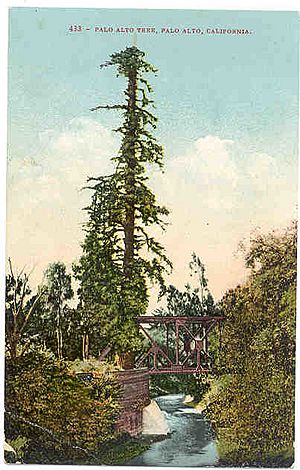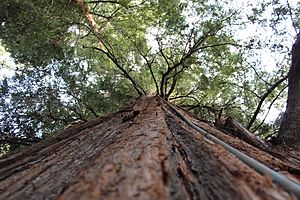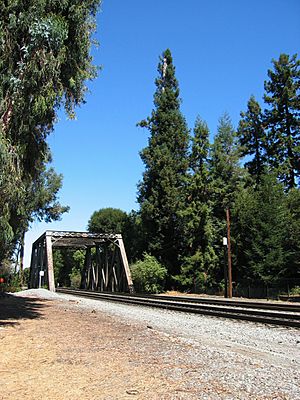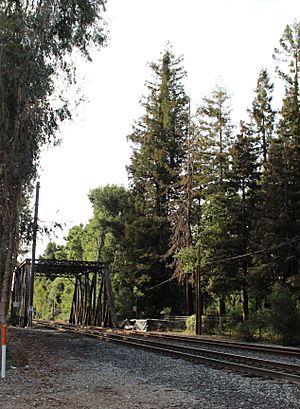El Palo Alto facts for kids
El Palo Alto (which means "the tall stick" in Spanish) is a very old and famous coastal redwood tree. You can find it in El Palo Alto Park, right next to San Francisquito Creek in Palo Alto, California, United States. This tree is special because of its long history. It even gave the city of Palo Alto its name!
Today, El Palo Alto stands about 110 feet (33.5 meters) tall. It used to be much taller, reaching 162.2 feet (49.4 meters) in 1814. Over time, its top branches died off because its roots couldn't reach enough water. The tree is also very wide, about 90 inches (2.3 meters) across. Its branches spread out about 40 feet (12 meters). In 1955, experts found out the tree was 1,015 years old! El Palo Alto originally had three main trunks. One trunk is now just a stump. Another trunk fell in 1886, but no one knows why.
History of El Palo Alto
This amazing tree is known as California Historical Landmark No. 2. It's famous for many reasons. It was a camping spot for the Portola Expedition in 1769. This group was exploring California. The tree was also often visited by the native Ohlone people. Later, it was used by surveyors to help map out El Camino Real, an important historical road. You can even see the tree on the official seal of the city of Palo Alto and on the seal of Stanford University. It's truly the origin of the city's name.
At the base of the tree, there's a special plaque that tells part of its story. It says that the Portola group camped under this giant redwood from November 6 to 11, 1769. This was when they discovered San Francisco Bay. The tree was also a meeting point for their scouting teams. In 1774, a priest named Padre Palou placed a cross here. He wanted to mark the spot for a new mission. A famous map from 1776, made by Pedro Font, even shows the tree. This makes El Palo Alto the first living California landmark ever officially drawn!
Two years after Padre Palou's visit, Padre Font came back with the De Anza Expedition. On March 30, 1776, he measured the tree. He wrote in his diary that it was "five and a half yards around." De Anza and Font found the wooden cross Padre Palou had left. However, they decided to build their mission in Santa Clara instead. This was because San Francisquito Creek didn't have enough water during the dry season.
Tree Health and Care
In 1776, the tree was about 135.7 feet tall. By 1814, it had grown to 162.2 feet. But from 1865 to 1955, the tree started to get sick. It had fewer branches and leaves. People worried the tree might die. In 1926, a bronze plaque was placed near the tree to honor it. By 1951, its height was down to 134.6 feet. In 1977, its dead top was removed, making it 126 feet tall. Today, it stands at about 110 feet.
The tree's health problems were caused by a few things. Smoke from coal-burning trains hurt it. Also, nearby wells lowered the water level in the ground. This meant El Palo Alto's roots couldn't reach enough water. Redwoods usually have shallow roots, so they need water close to the surface.
By the mid-1960s, the tree was very sick. Its top kept dying off. But in the late 1990s, the water level in the ground started to rise again. Many groups worked hard to save the tree. The Southern Pacific Railroad, the City of Palo Alto, and local people helped. They trimmed the dead parts of the tree. They also added soil and mulch around its base. They removed dead branches and sprayed for pests. They even put a pipe up its trunk to mist the top with water. Even though the tree is shorter now, it is much healthier than it was a century ago.
In 2004, young trees grown from El Palo Alto's seeds were planted. They went to the American Forests Historic Tree Nursery in Jacksonville, Florida. In August 2010, someone spray-painted the tree with graffiti, but it was cleaned soon after.
See also
 In Spanish: El Palo Alto para niños
In Spanish: El Palo Alto para niños





